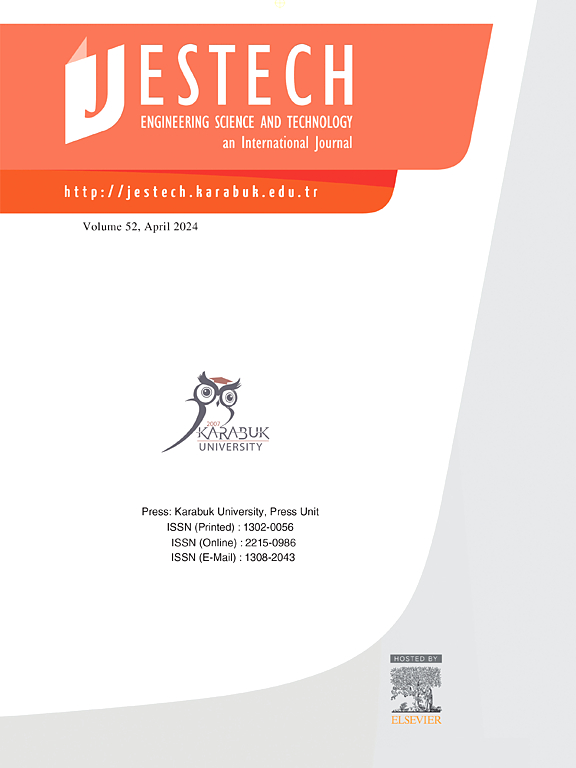CrackNet: A new deep learning-based strategy for automatic classification of road cracks after earthquakes
IF 5.4
2区 工程技术
Q1 ENGINEERING, MULTIDISCIPLINARY
Engineering Science and Technology-An International Journal-Jestech
Pub Date : 2025-06-27
DOI:10.1016/j.jestch.2025.102128
引用次数: 0
Abstract
Highways are one of the most preferred transport options. Timely maintenance of highways prevents higher maintenance costs in the future. Especially detecting deterioration on highways due to major earthquakes is of great importance. Because humanitarian and logistical material aid is provided to the earthquake areas through highways. Therefore, there is a need for system applications that automatically detect asphalt deterioration. In this study, the images of asphalt cracks that occurred in five different major cities in Turkey after two major earthquakes that occurred consecutively in the Elbistan region were analyzed. These cracks were labeled as major and minor by experts from the construction department. In the next stage, asphalt cracks were categorized with a new deep learning-based model. In the study, data reliability was increased with gradient-based preprocessing steps. In the feature extraction stage, a multi-scale and multi-input customized ConvMixer (MSMICM)-based model was used. In the classification stage, a new weighted-reliefF-subspace-SVM (WRSS) algorithm was developed. This proposed approach achieved 94.2% classification performance.
裂纹网:一种基于深度学习的地震后道路裂缝自动分类新策略
公路是最受欢迎的交通方式之一。及时维护高速公路可以防止未来更高的维护成本。特别是检测由于大地震而导致的公路老化是非常重要的。因为人道主义和后勤物资援助是通过高速公路提供给地震地区的。因此,需要一种能够自动检测沥青劣化的系统应用。在本研究中,分析了土耳其五个不同主要城市在埃尔比斯坦地区连续发生两次大地震后发生的沥青裂缝图像。这些裂缝被建筑部门的专家标记为主要和次要。接下来,使用一种新的基于深度学习的模型对沥青裂缝进行分类。在研究中,采用基于梯度的预处理步骤提高了数据的可靠性。在特征提取阶段,采用基于多尺度、多输入的自定义ConvMixer (MSMICM)模型。在分类阶段,提出了一种新的加权relief -subspace- svm (WRSS)算法。该方法的分类性能达到94.2%。
本文章由计算机程序翻译,如有差异,请以英文原文为准。
求助全文
约1分钟内获得全文
求助全文
来源期刊

Engineering Science and Technology-An International Journal-Jestech
Materials Science-Electronic, Optical and Magnetic Materials
CiteScore
11.20
自引率
3.50%
发文量
153
审稿时长
22 days
期刊介绍:
Engineering Science and Technology, an International Journal (JESTECH) (formerly Technology), a peer-reviewed quarterly engineering journal, publishes both theoretical and experimental high quality papers of permanent interest, not previously published in journals, in the field of engineering and applied science which aims to promote the theory and practice of technology and engineering. In addition to peer-reviewed original research papers, the Editorial Board welcomes original research reports, state-of-the-art reviews and communications in the broadly defined field of engineering science and technology.
The scope of JESTECH includes a wide spectrum of subjects including:
-Electrical/Electronics and Computer Engineering (Biomedical Engineering and Instrumentation; Coding, Cryptography, and Information Protection; Communications, Networks, Mobile Computing and Distributed Systems; Compilers and Operating Systems; Computer Architecture, Parallel Processing, and Dependability; Computer Vision and Robotics; Control Theory; Electromagnetic Waves, Microwave Techniques and Antennas; Embedded Systems; Integrated Circuits, VLSI Design, Testing, and CAD; Microelectromechanical Systems; Microelectronics, and Electronic Devices and Circuits; Power, Energy and Energy Conversion Systems; Signal, Image, and Speech Processing)
-Mechanical and Civil Engineering (Automotive Technologies; Biomechanics; Construction Materials; Design and Manufacturing; Dynamics and Control; Energy Generation, Utilization, Conversion, and Storage; Fluid Mechanics and Hydraulics; Heat and Mass Transfer; Micro-Nano Sciences; Renewable and Sustainable Energy Technologies; Robotics and Mechatronics; Solid Mechanics and Structure; Thermal Sciences)
-Metallurgical and Materials Engineering (Advanced Materials Science; Biomaterials; Ceramic and Inorgnanic Materials; Electronic-Magnetic Materials; Energy and Environment; Materials Characterizastion; Metallurgy; Polymers and Nanocomposites)
 求助内容:
求助内容: 应助结果提醒方式:
应助结果提醒方式:


